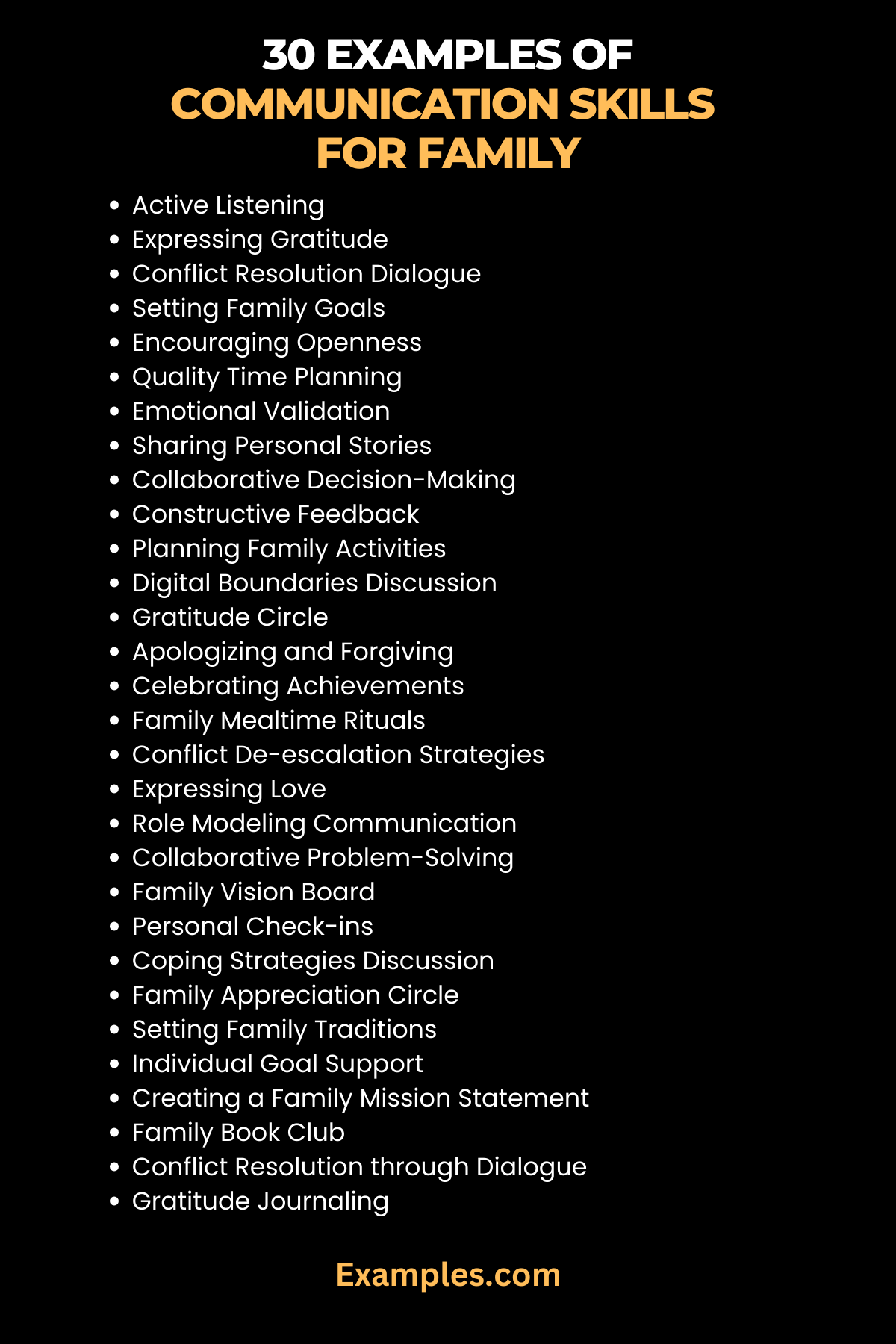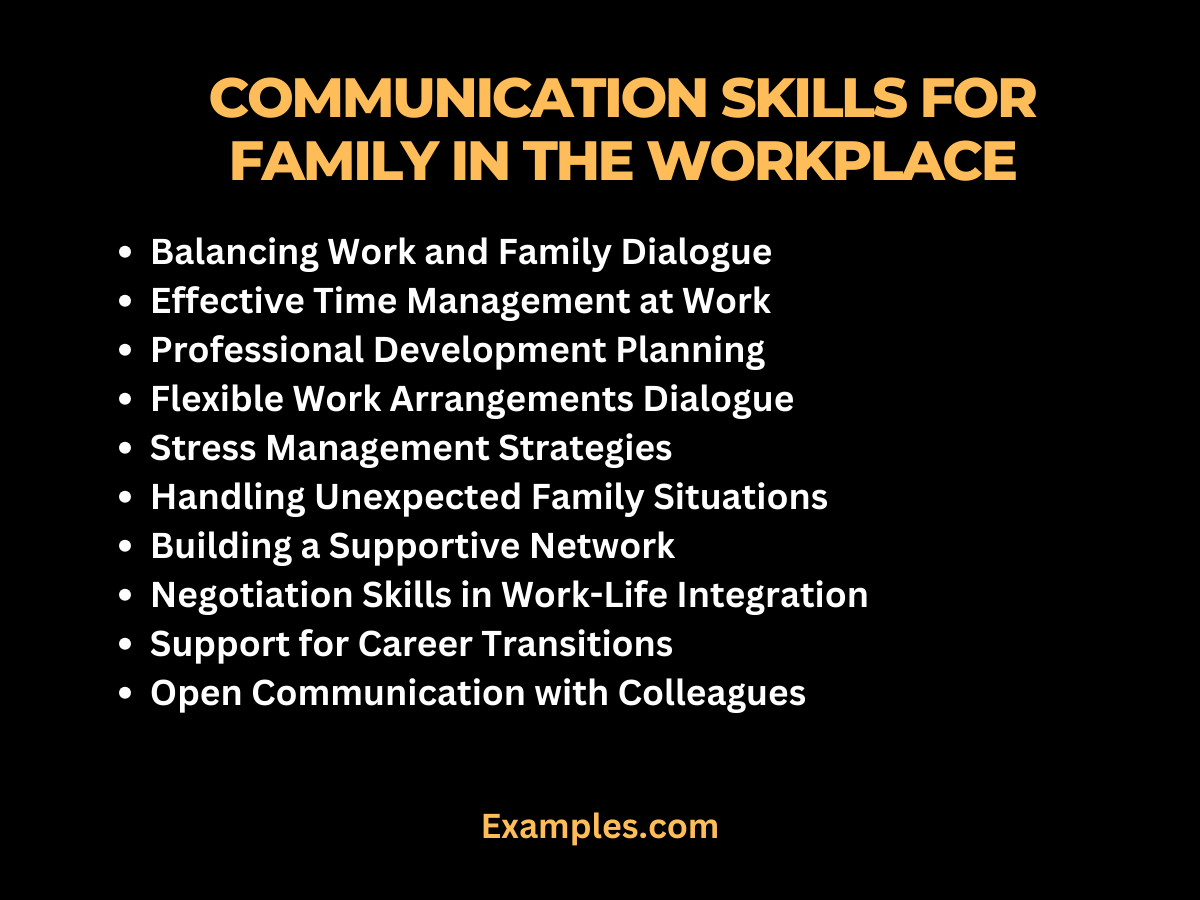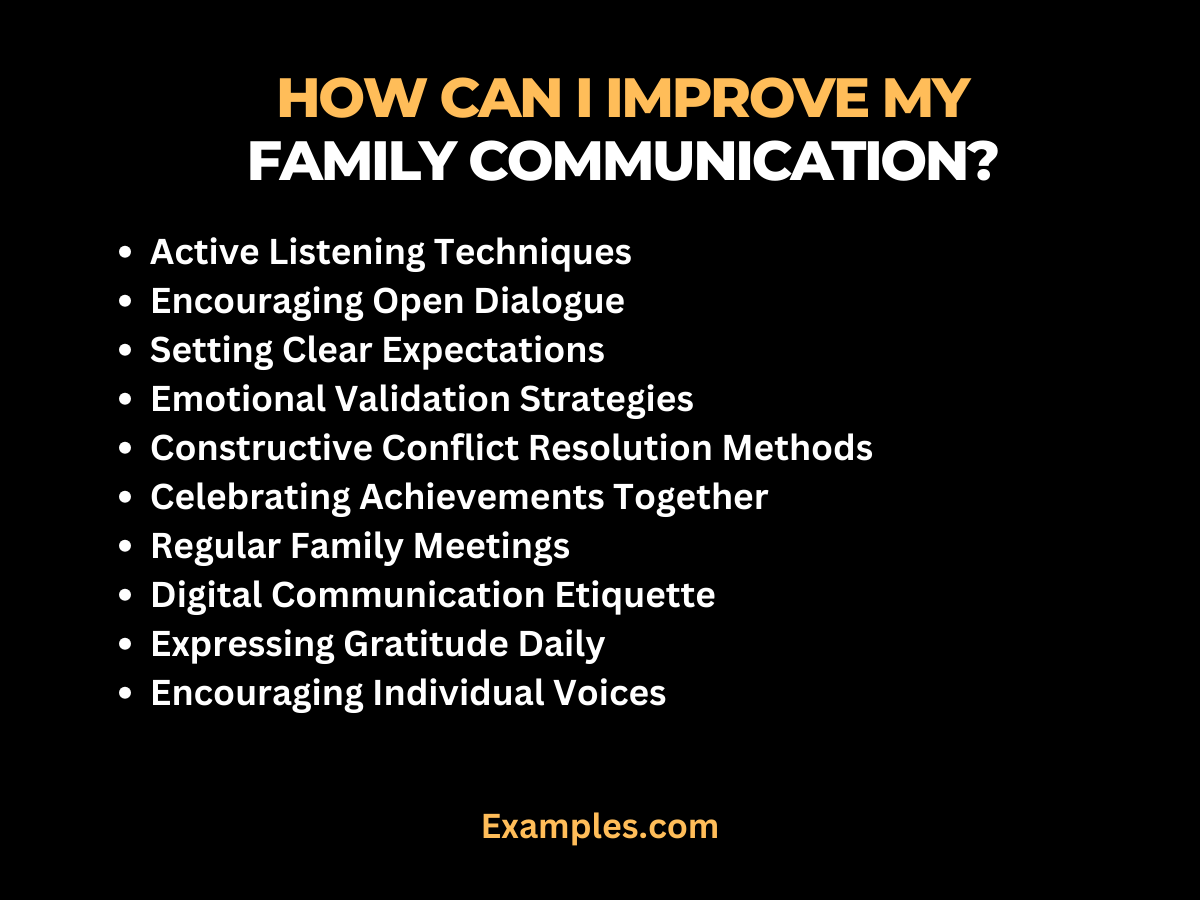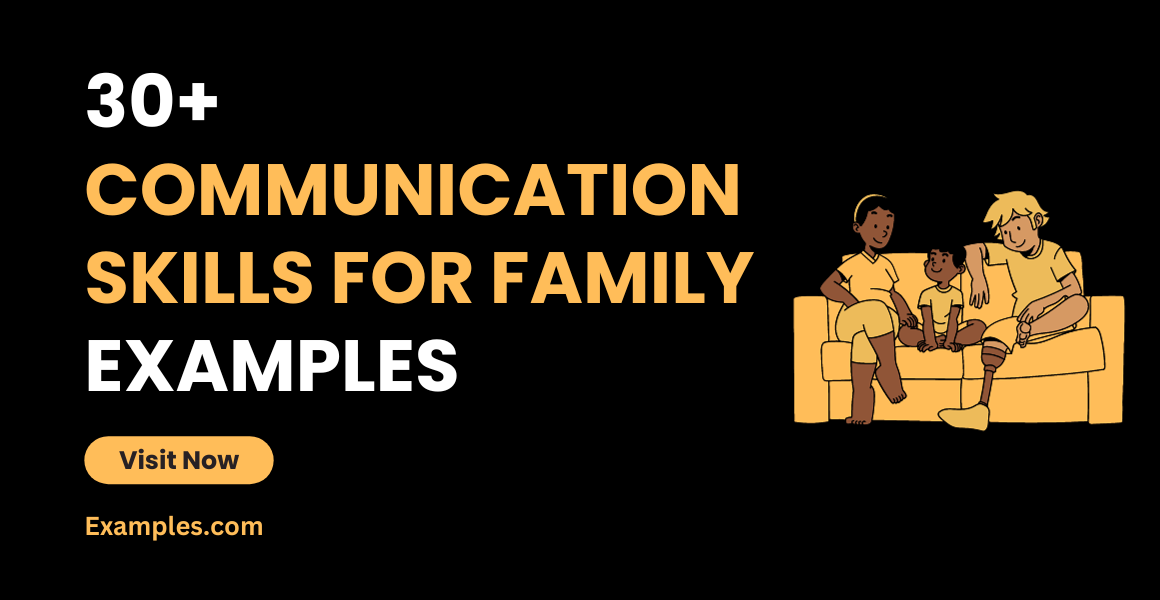Communication Skills for Family – 29+ Examples
Embark on a transformative journey of family connection through our comprehensive guide on Communication Skills for Family. Delve into actionable insights, expert tips, and real-life Communication Examples that empower you to foster strong and meaningful bonds within your family. From navigating challenging situations to celebrating shared triumphs, this guide is your roadmap to building enduring connections through effective communication strategies.
30 Examples of Communication Skills for Family
Elevate family dynamics with our guide featuring 30 Communication Skills for Family Examples. Explore actionable insights and expert tips for fostering meaningful connections. This resource equips you with the tools to navigate diverse scenarios, from everyday conversations to addressing sensitive topics, creating a harmonious family environment.

- Active Listening:
- Showcase attentive listening by repeating back what your family member says, promoting understanding.
- Expressing Gratitude:
- Strengthen bonds by saying, “Thank you for your help; your effort is truly appreciated.”
- Conflict Resolution Dialogue:
- Guide resolution with, “Let’s understand each other’s perspectives and find a solution together.”
- Setting Family Goals:
- Initiate a discussion with, “What goals do we want to achieve together as a family?”
- Encouraging Openness:
- Create a safe space with, “I value your thoughts. Share what’s on your mind without fear of judgment.”
- Quality Time Planning:
- Promote family togetherness by saying, “Let’s plan a day to spend quality time together.”
- Emotional Validation:
- Acknowledge feelings with, “I understand you’re upset. Let’s talk about it and find a resolution.”
- Sharing Personal Stories:
- Deepen connections by sharing personal experiences, fostering a sense of closeness.
- Collaborative Decision-Making:
- Involve everyone with, “Let’s make decisions together to ensure everyone’s needs are considered.”
- Constructive Feedback:
- Provide feedback that guides growth with, “Your effort is commendable. Here’s how we can improve.”
- Planning Family Activities:
- Initiate with, “What activities would each family member enjoy participating in together?”
- Digital Boundaries Discussion:
- Establish boundaries with, “Let’s discuss our family’s approach to digital device usage.”
- Gratitude Circle:
- Create a routine where each family member expresses gratitude for something positive daily.
- Apologizing and Forgiving:
- Model humility by saying, “I’m sorry if my actions hurt you. Let’s forgive and move forward.”
- Celebrating Achievements:
- Recognize and celebrate family milestones, fostering a positive and supportive environment.
- Family Mealtime Rituals:
- Enhance connections by having regular family meals, promoting conversation and bonding.
- Conflict De-escalation Strategies:
- Teach de-escalation with, “When tensions rise, let’s take a break and return to the discussion calmly.”
- Expressing Love:
- Verbalize affection by saying, “I love you,” reinforcing emotional bonds within the family.
- Role Modelling Communication:
- Demonstrate healthy communication for children by maintaining respect and clarity.
- Collaborative Problem-Solving:
- Foster teamwork by saying, “Let’s work together to find solutions to family challenges.”
- Family Vision Board:
- Create a vision board together, expressing individual and collective family aspirations.
- Personal Check-ins:
- Regularly ask family members, “How are you feeling today? Is there anything you’d like to share?”
- Coping Strategies Discussion:
- Promote emotional well-being by discussing effective coping strategies during challenging times.
- Family Appreciation Circle:
- Express appreciation for each family member, reinforcing a positive atmosphere.
- Setting Family Traditions:
- Initiate with, “What traditions can we establish to strengthen our family bond?”
- Individual Goal Support:
- Encourage each family member’s goals with, “How can we support your personal aspirations?”
- Creating a Family Mission Statement:
- Define family values together, crafting a mission statement to guide collective actions.
- Family Book Club:
- Stimulate discussion by choosing a book for the family to read and discuss together.
- Conflict Resolution through Dialogue:
- Encourage open conversation during conflicts, saying, “Let’s talk it out and find a resolution together.”
- Gratitude Journaling:
- Foster a positive mindset by maintaining a family gratitude journal, sharing entries regularly.
Communication Skills for Family Sentence
Unlock the potential for meaningful connections within your family with our guide on Communication Skills for Family Sentence Examples. Explore actionable insights, tips, and real-life examples to enhance communication and foster stronger bonds in various aspects of your family life.
- Encouraging Openness at Home:
- Foster trust with the sentence, “Your thoughts matter; share them openly without fear of judgment.”
- Empathetic Dialogue in Nursing:
- Show compassion with the phrase, “In challenging moments, use empathetic words to comfort your family member.”
- Conflict Resolution at the Workplace:
- Navigate conflicts with, “In professional settings, discuss differences calmly to find constructive solutions.”
- Quality Time Planning at Home:
- Strengthen family ties with, “Plan activities together, ensuring quality time for shared experiences.”
- Digital Boundaries Discussion in Nursing:
- Establish digital etiquette with, “Discuss guidelines for responsible online communication within the family.”
- Collaborative Decision-Making in the Workplace:
- Enhance teamwork with, “Involve family members in decision-making for a collective sense of ownership.”
- Gratitude Circle at Home:
- Promote positivity by starting a daily family circle where each member expresses gratitude.
- Celebrating Achievements at Nursing:
- Acknowledge success with, “Celebrate accomplishments, recognizing the dedication of your family members.”
- Role Modelling Communication at the Workplace:
- Demonstrate effective communication for colleagues, showcasing respect and clarity.
- Family Vision Board at Home:
- Foster shared aspirations with, “Create a family vision board, articulating individual and collective goals.”
Communication Skills for Family in Nursing
Navigate the intricacies of family dynamics in nursing settings with our guide on Communication Skills for Family. From empathetic dialogue to celebrating achievements, these skills empower you to build stronger connections with families in healthcare scenarios.
- Empathy and Emotional Support:
- Provide comfort with, “Use empathetic words to reassure and support family members during challenging times.”
- Healthcare Decision Collaboration:
- Involve families in healthcare decisions, ensuring transparency and a sense of shared responsibility.
- Crisis Communication Strategies:
- Navigate crises with, “In emergencies, communicate transparently, offering information and emotional support.”
- End-of-Life Conversations:
- Approach delicate topics with sensitivity, using, “Discussing end-of-life decisions requires compassion and clarity.”
- Health Education Dialogue:
- Promote understanding with, “Educate families on healthcare matters using clear and easily comprehensible language.”
- Updates and Progress Sharing:
- Maintain open communication with, “Regularly update families on patient progress, fostering trust and understanding.”
- Medication and Treatment Explanation:
- Clarify treatment plans with, “Use simple language to explain medications and procedures, ensuring family comprehension.”
- Respecting Cultural Differences:
- Acknowledge diversity with, “Respect and consider cultural differences when communicating with families in healthcare settings.”
- Family Support Coordination:
- Facilitate support with, “Coordinate resources and services for families, ensuring comprehensive assistance.”
- Expressing Gratitude in Healthcare:
- Show appreciation with, “Thank families for their trust and collaboration in the healthcare journey, reinforcing a positive connection”.
Communication Skills for Family in the Workplace
Mastering communication within your family in the workplace is essential for a harmonious work-life balance. Explore our guide on Communication Skills for Family in the Workplace, offering insights and real-life examples to strengthen family connections in professional settings.

- Balancing Work and Family Dialogue:
- Initiate discussions with employers using, “Create a work schedule that accommodates both professional responsibilities and family priorities.”
- Effective Time Management at Work:
- Optimize productivity with, “Explore strategies for efficient time management, ensuring a balance between work and family.”
- Professional Development Planning:
- Chart your career path with, “Align professional development with career goals while accommodating family commitments.”
- Flexible Work Arrangements Dialogue:
- Discuss flexibility with, “Explore work arrangements that accommodate family needs without compromising productivity.”
- Stress Management Strategies:
- Promote well-being with, “Implement stress management initiatives to support employees in maintaining work-life balance.”
- Handling Unexpected Family Situations:
- Establish protocols with, “Communicate unforeseen family situations transparently, allowing for understanding and support.”
- Building a Supportive Network:
- Foster a positive workplace culture with, “Create an environment that supports employees in managing professional and family roles.”
- Negotiation Skills in Work-Life Integration:
- Initiate discussions on integration with, “Explore ways to create a work environment that supports a healthy balance between work and family.”
- Support for Career Transitions:
- Facilitate transitions with, “Communicate plans for career changes transparently, seeking support from family and colleagues.”
- Open Communication with Colleagues:
- Build understanding with, “Value clear communication in the workplace, promoting transparency and collaboration among colleagues.”
What Are Family Communication Skills?
Family communication skills encompass a range of abilities that facilitate understanding, empathy, and collaboration among family members. These skills go beyond verbal expression, incorporating nonverbal cues, active listening, and the ability to navigate various communication styles within the family dynamic.
- Active Listening:
- Active listening involves fully concentrating, understanding, responding, and remembering what is being said. It’s a foundational skill that fosters empathy and mutual understanding within the family.
- Empathy and Emotional Validation:
- The ability to comprehend and resonate with the emotions of family members creates a supportive environment. Emotional validation acknowledges the validity of each family member’s feelings.
- Clear and Open Communication:
- Transparency and openness are crucial for avoiding misunderstandings. Encouraging family members to express themselves freely and clearly contributes to a healthy communication environment.
- Positive Reinforcement:
- Reinforcing positive behaviours through praise and encouragement strengthens family bonds. Acknowledging and appreciating each other’s efforts fosters a positive atmosphere.
- Problem-Solving Skills:
- Teaching effective problem-solving skills enables families to navigate challenges collaboratively. It encourages a solution-oriented mindset, fostering resilience.
- Setting Boundaries:
- Establishing clear boundaries is essential for a balanced family dynamic. Communicating expectations and consequences ensures a structured and secure environment.
- Digital Communication Etiquette:
- In the digital age, understanding and adhering to proper online communication etiquette are essential. Discussing guidelines ensures responsible use of technology within the family.
- Consistent Communication:
- Regular and consistent communication builds trust. Having routine check-ins or family meetings creates a platform for open discussions and updates.
How Can I Improve My Family Communication?
Enhancing family communication involves a multifaceted approach that considers the unique dynamics within each household. Here’s a comprehensive guide on improving your family communication

- Active Listening Techniques:
- Cultivate attentive listening habits, showing family members that their thoughts and feelings are valued.
- Encouraging Open Dialogue:
- Create a safe space for open communication, allowing each family member to express themselves freely without fear of judgment.
- Setting Clear Expectations:
- Establish transparent expectations and boundaries, ensuring everyone is on the same page regarding responsibilities and rules.
- Emotional Validation:
- Acknowledge and validate each other’s emotions, fostering empathy and understanding within the family unit.
- Constructive Conflict Resolution:
- Equip family members with strategies for resolving conflicts amicably, emphasizing compromise and effective communication.
- Celebrating Achievements Together:
- Create a culture of celebration within the family, recognizing and rejoicing in individual and collective accomplishments.
- Regular Family Meetings:
- Institute regular family meetings to discuss concerns, plans, and aspirations, ensuring everyone has a voice in family decisions.
- Digital Communication Etiquette:
- Establish guidelines for digital communication, promoting responsible and respectful online interactions among family members.
- Expressing Gratitude Daily:
- Foster positivity by incorporating daily gratitude expressions, highlighting the positive aspects of family life.
- Encouraging Individual Voices:
- Encourage each family member to express their opinions and ideas, promoting a sense of autonomy and individuality.
In the intricate tapestry of family life, mastering Communication Skills is the thread that weaves lasting connections. This guide, rich with insights and real-world examples, equips you to navigate diverse family scenarios with empathy and understanding. Embrace these skills, cultivate meaningful dialogue, and watch as your family bonds flourish into resilient and harmonious relationships.



